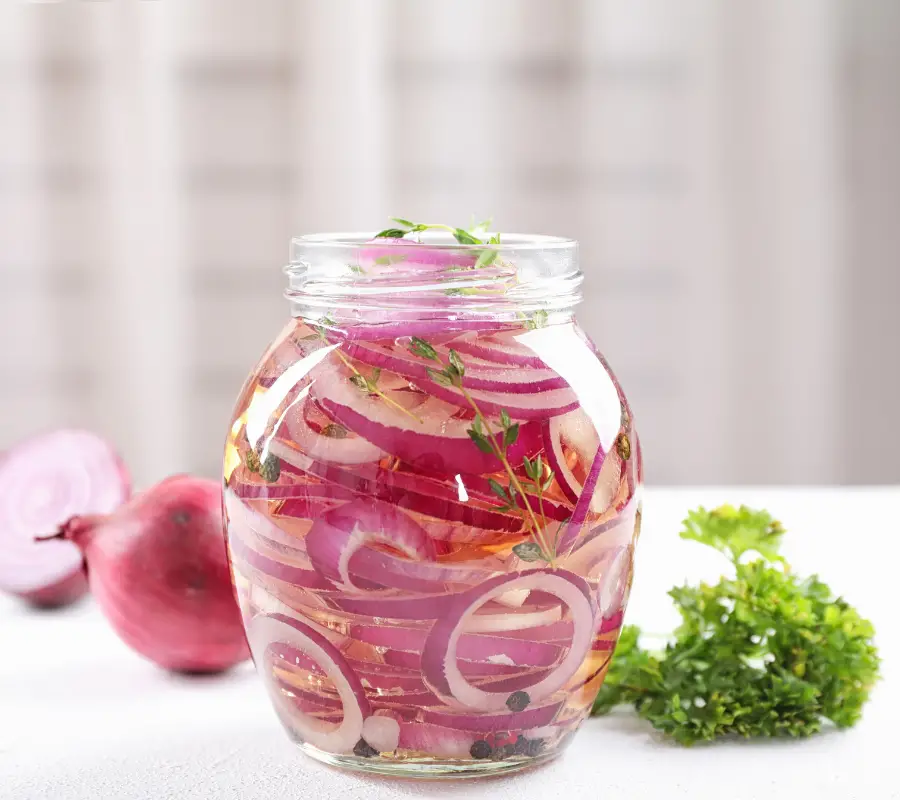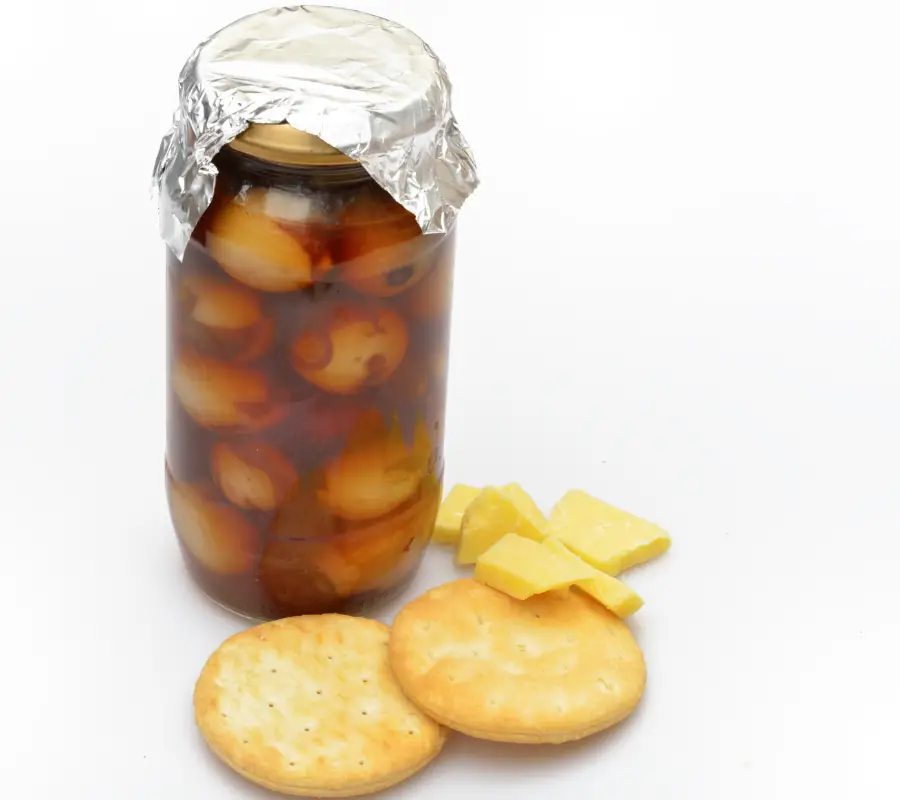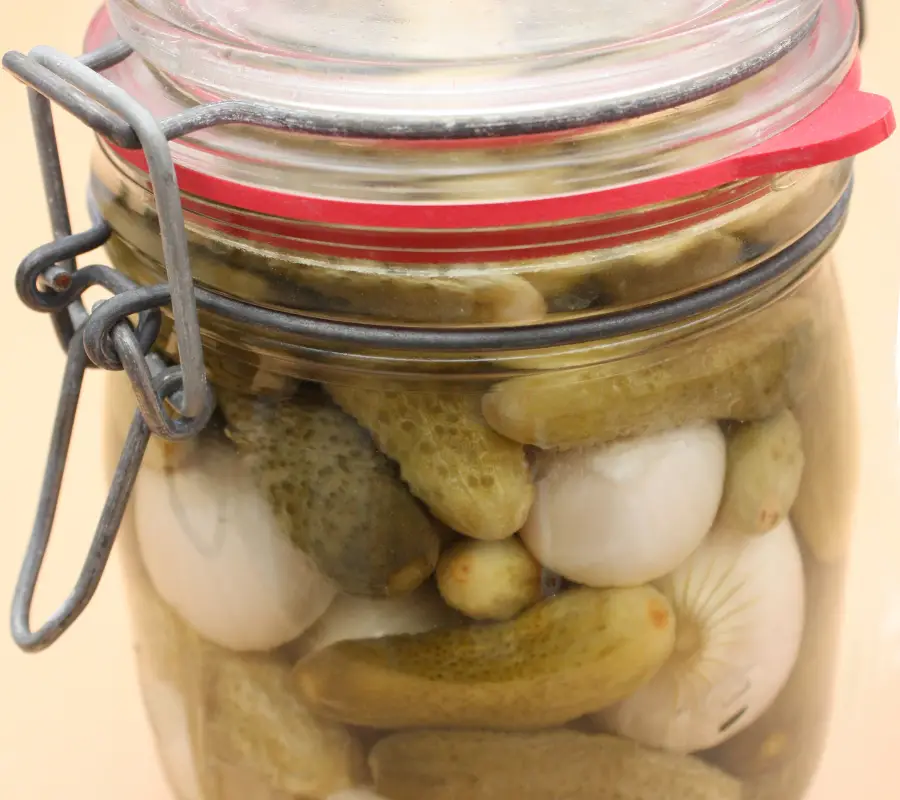The Best Vinegar For Pickling: Which Ones?
When you decide to delve into the world of pickling, one of the key ingredients to consider is vinegar. The type of vinegar you choose can significantly impact the flavour, colour, and overall quality of your pickled creations. In this post, we’ll introduce you to some popular types of vinegar that can be used in pickling and how their characteristics influence the final product.
As you embark on your pickling journey, you’ll likely come across various types of vinegar, such as distilled white vinegar, malt vinegar, cider vinegar, wine vinegar, and rice vinegar. Each has its unique attributes, contributing to the taste and texture of the pickled items. It’s essential to understand the acidity levels and flavours of these vinegar, as they will ultimately determine the success of your pickling endeavours.
Armed with this knowledge, you’ll be better prepared to choose the best type of vinegar for your pickling projects. Whether you’re aiming for a subtly sweet or tangy finish, these varieties will offer you a range of possibilities to create delightful and flavourful pickled treats. So go ahead and explore the world of pickling vinegar with confidence.

Types of Vinegar for Pickling
White Vinegar
White vinegar, also known as distilled white vinegar, is the most common type of vinegar used in pickling. It has a clear colour and a mild flavour, making it perfect for preserving the natural taste and appearance of the food you’re pickling. Look for a white vinegar with 5% acetic acid content.
Apple Cider Vinegar
Cider vinegar, or apple cider vinegar, is another option for pickling. It has a slightly sweet taste and amber colour, which can affect the appearance of your pickled produce. Be sure to use apple cider vinegar with at least 5% acetic acid content for the best results.
Wine Vinegar
Wine vinegar, made from red or white wine, is another choice for pickling. It adds a subtle fruity flavour to your pickles. Because it is typically lighter in colour than malt vinegar, it won’t significantly alter the appearance of your pickled items. Always check the wine vinegar label to ensure it has a 5% acetic acid content before using it for pickling.
Malt Vinegar
Malt vinegar, made from malted barley, has a dark brown colour and a robust flavour that a great for pickled onions! Due to its colour, it can turn your pickled items a shade of brown. It is best used with strongly flavoured produce. You can use malt vinegar for pickling as long as it contains 5% acetic acid.
Rice Vinegar
Rice vinegar, made from fermented rice, is an alternative for pickling, especially in Asian-style recipes. It has a mild, slightly sweet flavour and is lighter in colour. Be sure to use rice vinegar with a 5% acetic acid content for proper pickling.
Pickling Vinegar
Pickling vinegar is a commercial product specially formulated for pickling with a higher acetic acid content, usually around 7%. Some of these vinegars may also contain added spices. You can find pickling vinegar in many grocery stores, and is suitable to use as is, without dilution.
Homemade Vinegar
You can make your own pickling vinegar at home by infusing regular vinegar with your choice of spices, sugar, and bay leaves. To make your homemade pickling vinegar, simmer vinegar with sugar and bay leaves, allow the mixture to cool and infuse, and store it in a sterilized jar for at least two weeks before use.

Components of Pickling
Acid
In pickling, the primary acid used is vinegar. Various types of vinegar can be employed, such as distilled white vinegar, malt vinegar, cider vinegar, wine vinegar, and rice vinegar. The acidity is crucial for preservation – it lowers the pH, preventing harmful bacteria from growing. Ensure the vinegar you use contains at least 5% acetic acid for effective pickling.
Salt
Salt is another essential component in pickling, serving two critical roles: adding flavour and acting as a preservative. Pickling or kosher salt works best for pickling as it dissolves quickly, has no additives, and doesn’t cloud the brine3. Avoid using regular table salt or sea salt with additives, as they may affect the quality of your pickles.
Sugar
Sugar is often added to the pickling process to balance out the sourness from the vinegar. The sugar also helps to preserve the colour and texture of the ingredients being pickled4. You can adjust the sugar levels to your taste preference, but make sure not to deviate too far from the original recipe if you want to maintain the preserving qualities.
Spices
Spices add flavour and aroma to the pickling process. Some common spices used in pickling include dill, mustard seeds, garlic, and even cinnamon1. Feel free to experiment with different spices according to your preferences, but always consider their compatibility with the ingredients you are pickling.
Water
Water is included in the pickling brine to create a liquid solution of vinegar, salt, sugar, and spices. When selecting water for pickling, make sure to use soft water, free from minerals and impurities3. Hard water with high mineral content can affect the pickling process and the final quality of your pickles.
In summary, pickling requires a careful balance of acidity, salt, sugar, spices and water to create deliciously preserved foods. Pay attention to the quality of your ingredients and follow your recipe to achieve optimal results.

Pickling Process
Preparation
To begin your pickling journey, select fresh vegetables such as cucumbers, green beans, or even cauliflower. Ensure the vegetables are unwaxed and washed thoroughly, especially around the stem area, to remove any soil harbouring bacteria. For pickling cucumbers, it’s best to use those that are 1 1/2 inches in length for gherkins and 4 inches for dills. Be sure to pickle the cucumbers within 24 hours after picking them.
Heating the Brine
To prepare the pickling solution, you need to mix water, salt, vinegar, and sometimes sugar in a saucepan. Vinegar choices include distilled white vinegar, malt vinegar, cider vinegar, wine vinegar, and rice vinegar, each lending a unique flavour. However, distilled white vinegar is a popular choice as it doesn’t add much flavour or leach colour to the vegetables. Place the saucepan on the stove to heat the solution, ensuring that the sugar dissolves, and stir in spices like bay leaves or dill.
Pouring and Sealing
Once you have heated the pickling brine, allow it to cool slightly. Meanwhile, arrange your vegetables in sterilised jars. Then, slowly pour the brine over the vegetables, making sure they are completely submerged in the liquid. Seal the jars tightly to prevent bacteria and yeasts from spoiling the pickles.
Fermenting and Storing
The fermentation process now begins. This involves the reaction between the acidic solution and the vegetables, with the aim of preserving them and enhancing their flavour. Store the jars in a cool, dark place away from direct sunlight. The pickling process may take anywhere from 2 weeks to 3 months, depending on the desired flavour intensity. Once opened, refrigerate the pickles to maintain their freshness. If properly sealed and stored, pickled vegetables can have a relatively long shelf life.
Safety Considerations
When pickling, it’s important for you to take safety precautions to prevent the growth of harmful microorganisms.
Cleanliness is an important factor to consider during pickling. To prevent contamination by microorganisms, ensure the following:
- Wash your hands, utensils and the produce thoroughly, particularly around the stem area, which may contain bacteria.
- Sterilise your jars and lids before using them to store your pickles. You can do this by boiling them in water for about 10 minutes or running them through a hot dishwasher cycle.
Finally, store your pickled products in a cool, dark place and wait for the recommended time before opening the jars to allow the flavours to fully develop. Remember that proper storage and patience are key to delicious, safe pickles.
Benefits and Uses of Pickling
Pickling is an excellent way to preserve and enhance the flavours of various foods. By incorporating different vinegar types, such as distilled white vinegar, malt vinegar, cider vinegar, wine vinegar, and rice vinegar, you can create a wide variety of pickle recipes, each with its unique tastes and textures.
One significant benefit of pickling is the nutritional value it adds to your diet. Fermented and pickled foods are rich in probiotics, which aid in maintaining the balance of good bacteria in your digestive system. Including vinegar pickles in your meals can thus support your digestive health.
Another advantage of pickling is that it helps preserve the nutritional value of the food, ensuring you have a constant supply of nutrients, such as calcium. For instance, pickled cucumbers are high in calcium, providing approximately 13% of the recommended daily intake in just one medium-sized pickle.
While you may already be familiar with the culinary uses of pickling, it is worth noting that vinegar combined with other ingredients can also serve as an effective cleaning agent. Vinegar’s acetic acid content is particularly useful in removing stains, deodorising smells, and cutting through grease.
Influence on Vinegar Choice
When choosing a vinegar for pickling, several factors can influence your decision, such as the fruits or vegetables you are pickling, desired acidity level, durability of the final product, and cost.
Firstly, consider the type of fruit or vegetable you plan to pickle. Some vinegars pair better with certain products, enhancing their flavour and colour. For example, using cider vinegar when pickling apples or pears complements their natural sweetness, while white wine vinegar works well with cucumbers.
The level of acidity is crucial in pickling since it assures proper preservation and food safety. It’s advisable to use vinegars with 5-7% acidity, such as white distilled vinegar or cider vinegar. Maintain the proper acidity level to prevent the growth of harmful bacteria and ensure that your pickles last.
The process of pickling often involves soaking the produce, like cucumbers, in a vinegar solution. As a result, another aspect for you to consider is the soaking time which can affect the final outcome. Certain vinegars may require a longer soak to achieve the desired flavour and texture, while others may offer a quicker solution. Experimenting with different vinegars and soak durations can help you determine your preference.
Lastly, keep in mind the cost and availability of the vinegar you choose. While some exotic or specialty vinegars may add a unique flavour to your pickles, these options can be more expensive and harder to find. Stick to widely available and cost-effective choices, such as distilled white or malt vinegar, for a budget-friendly approach to pickling.
By considering these factors and experimenting with various vinegars, you can achieve the best pickling results for your desired taste and budget.
Customising Pickling Recipes
When personalising your pickling recipes, there are various types of vinegar you can experiment with. Each vinegar brings its unique flavour, allowing you to create a wide variety of pickles.
To create a brine, simply use equal parts of your chosen vinegar and water. You can further customise the taste by adding sugar or salt according to your preference. For an exciting twist, consider incorporating various spices and flavourings to the brine, such as:
- Mustard seeds
- Chilli flakes
- Peppercorns
- Cinnamon
- Cloves
- Coriander
When choosing vegetables for your pickling adventures, remember that unwaxed, pickling cucumbers are ideal. They provide the desired crunchy texture and allow the brine to penetrate well. To ensure optimal freshness and quality, aim to pickle cucumbers within 24 hours after picking.
Remember that you can also pickle other vegetables and fruits to explore different taste profiles. Here are a few suggestions to get you started:
- Carrots
- Green beans
- Cauliflower
- Onions
- Beets
- Apples
Lastly, don’t be afraid to experiment with various combinations of ingredients, vinegar types, and pickling techniques. By doing so, you’ll find the perfect pickling recipe tailored to your taste buds. Happy pickling!